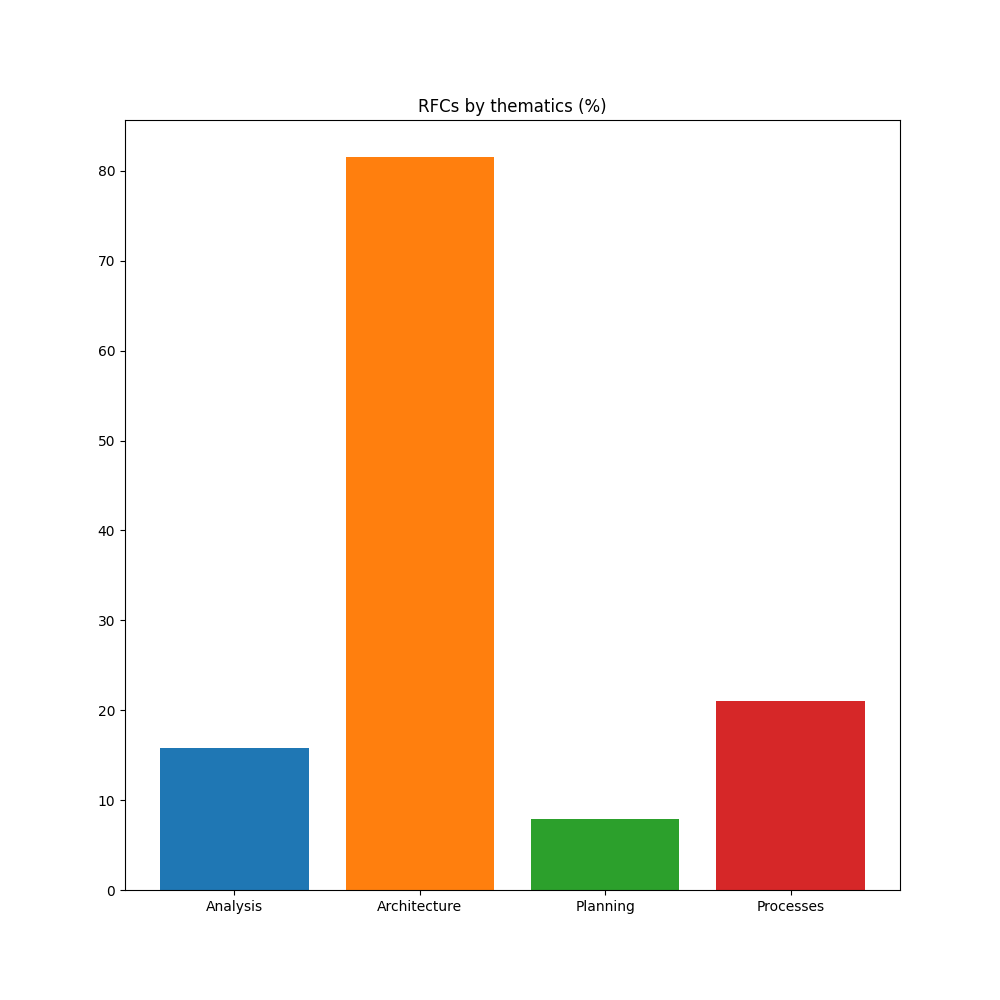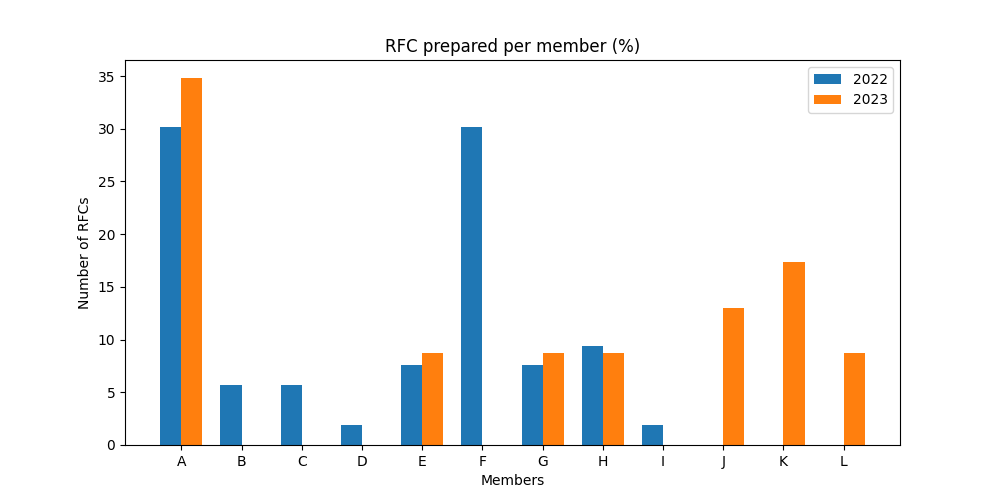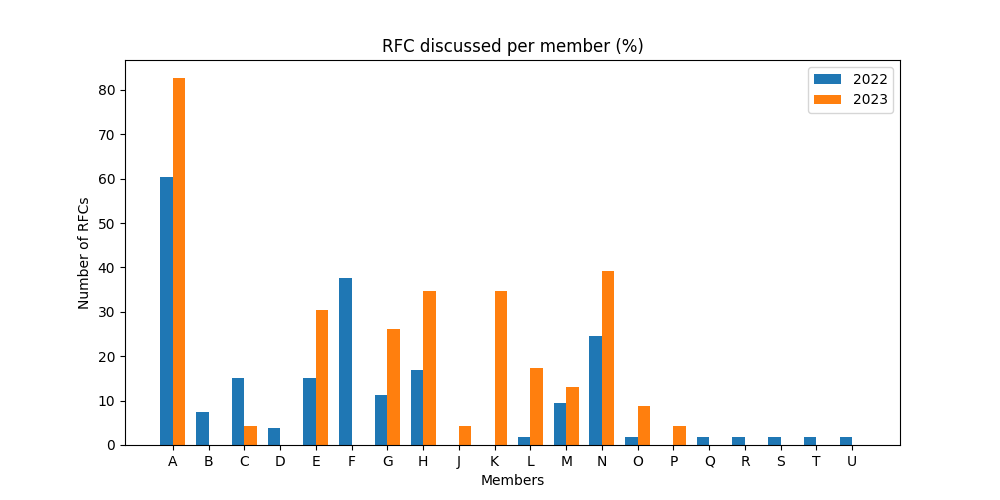Two years of writing RFCs — statistics ru en

Slightly more than two years ago, I became a Lead/Engineering Manager for Palta's payment team. I left the company at the end of 2023 for another sabbatical [ru].
It is time to sum up. I will start with my favorite initiative.
From the first month, I promoted the idea of preceding major changes with text documents — RFC — Request for Comments.
In this post, I will analyze two years of applying this practice to share the experience, summarize the results, and have convincing arguments for my next job.
What is RFC, what do they look like, and why are they needed
The RFC concept is quite well known by engineers, but it is not precisely defined. Everyone understands it in their own way.
So, for beginning, I will briefly outline my vision, which is based on several postulates:
- People's comfort is more important than formalities.
- Most developers do not make Google, most companies are not the size of Google, etc. Most of us are not responsible for people's lives and health.
- It is more convenient to work in small teams.
- Therefore, we can work simpler.
Request For Comments vs Request For Change
People interpret the abbreviation RFC differently:
- Request for Comments
- Request for Change
I prefer the first variant because it is broader and less demanding on developers.
When a developer writes a "request for change," he/she formally signs it "with their own blood," which is not always possible and can be uncomfortable. Preparing such a document takes more time, and the potential profit may not exceed the costs.
By requesting comments, an author can relax a little and allow themselves to make mistakes. Therefore, a developer can be more creative and prepare an RFC faster. Yes, something may be missed, but such errors can be caught during document discussions or even in later stages of development.
Document structure
The most famous documents of this kind: classical RFC, Python Enhancement Proposal, and others — are very formal. It is understandable that more responsibility leads to more formalities. Writing internet standards or changing a programming language is no joke.
However, although we were a payment team, we were not responsible for the future of all humanity and did not have hundreds of stakeholders. Therefore, RFCs were initially introduced without a fixed structure. The main criterion was that "the readers should understand the document."
Several times, we discussed the formalization of the RFC structure. We agreed that on our scale, the harm from tightening the screws would be greater than the benefit.
In fact, after some practice, the general structure was applied without explicit standardization. Teammates looked at each other's documents and adopted the best practices without special requirements to follow a specific form.
For example, I am a little obsessed with formal structure but did not require it from others. Quick preparation of structured documents is a separate skill that not everyone has and not everyone wants to develop. We should not force people to learn such skills unless they absolutely need them.
Examples of RFC topics
The topics of our RFCs were limited to four themes: architecture, processes, analysis, and planning. Later in the post, you will see a lot of charts with these themes, but for now, just a few actual RFC titles to avoid being unfounded:
- The architecture of our fraud prevention system
- Synchronization of subscriptions changes
- Metrics
- Architecture vision
- Comments on OKRs for Q1/23
- Requirements for a project management tool
- Testing and test process
- Review & better classification of technical tasks
- Open questions about work processes
Why RFCs are helpful
In short, this is the practice of thinking through writing at the team level. Read the text at the link if you want to dive deeper into the topic.
Each activity should leave an artifact. RFC is an artifact of the mental work that all developers do, but rarely save results. This leads to losing a lot of work over time — it just fades from memory. RFCs save such results.
By transferring thoughts into text, a person verifies their mental models [ru]. Even simple writing down thoughts improves understanding of the task, reveals errors, and so on.
Cheap knowledge base. It is cheap because RFCs do not need to be kept up to date, like regular documentation. At the same time, they remain useful and relevant. This is the history of the project's development, which is very convenient when dealing with technological archeology.
Knowledge exchange. It is not always possible to quickly transfer developers between parts of the project so that they share knowledge in practice. This is expensive. Discussing RFCs allows team members to share essential knowledge about the project.
Fast feedback. The sooner you find a mistake, the cheaper it is to fix it. RFCs allow you to find problems before they are transferred to a code, which is very cheap.
Simplifies onboarding. A new employee can be sent to read the RFCs in order; after that, they will more or less understand what is happening and what path the project has taken.
Asynchronous discussions (chats, forums, comments) are more effective than synchronous (meetings). I have not yet met a person who could immediately discuss complex things in real time. I can't do it either. Asynchronous communication improves discussions and helps developers stay in their flow by reducing unexpected breaks.
Introduction to collected statistics
In the following text there will be several parts with graphs. At the beginning of each part there will be an introduction: what is shown, what the graphs indicate, etc.
But first, a few notes on the data and the collection method:
- I am the initiator of the practice, and I analyzed it myself. Some biases are inevitable, take this into account.
- We kept the documentation in Notion. To get the data, I had to export the documents as HTML and parse them. I checked the code, but mistakes are possible.
- For some documents, it was difficult to determine the author: was it a full collaboration, or did one person make the document template and the other fill it in? In case of such questions, I tried to determine the main author from memory.
- I determined the topic of the RFC and the document status based on my expert opinion and memory. The history is only for two years, the documents are pretty clear, everything has passed through me, so there should be no significant inaccuracies.
- The data is maximally anonymized. No names, nicknames, titles, etc. Only numbers and graphs. The project is alive, tied to money. I don't want to deal with unnecessary approvals.
- The statistics were collected exactly for two calendar years. During this time, both the team and the project changed. This should be taken into account. Also, it is visible in the graphs.
- The core team grew from 3 to 7 people. At the end of the second year, there were 19 people on the team's Slack channel, all of them can be considered stakeholders of the practice. Most of them participated in the discussion of at least one document.
Statistics
The dynamics of RFC preparation
- A total of 76 RFCs were prepared.
- The number of RFCs in the first year is twice as high as in the second. The first year was about laying the groundwork, and the second was about tuning and implementing more business tasks.
- The dynamics of the number of RFCs per quarter show how the development gained momentum and reached its peak in the third quarter of the first year, after which the number of major changes began to decrease gradually. I think they will remain at the level of 3 +/- 1 RFC per quarter.


Author breakdown
- The statistics are anonymous. Names are replaced with letters. If you are from my team, write me a direct message, I will give you a decryption.
- You can guess that
Ais me — the author with the most of the RFCs. Firstly, I was the lead. Secondly, you can only introduce practices by your own example. - It was pleasantly surprising that only a third of the RFCs were created by me. I thought it would be about a half.
- The breakdown of authors per year shows how the team had changed. New people came, and some left.
- Everyone wrote RFC. In most cases, the first RFC document was prepared during the probationary period. We tried to provide an opportunity to do something significant during this time.
- On annual graphs, you can see that all team members participated in the RFC preparation approximately equally. With a correction for spikes, which are typical for a small sample: at one time, we actively worked on one part of the project with one team member as an expert; at another time — on another part with another team member as the feature owner.




Relevance of documents
We never updated RFCs; they are like historical records. Therefore, from a historical point of view, all of them are relevant.
But they can still be divided by their reflection on the project's current state (at the time I left).
I identified 4 states:
applied— at least a part of an RFC had been applied to the project in some form. It was in the code or in the processes.planned— the team had discussed and approved the RFC, but it had not yet been applied due to other planning priorities. Usually, these were significant changes in the architecture that did not need to be made right now but needed to be prepared for.applied & deprecated— the changes were applied, but then completely removed. For example, they did not work as expected, or the project concept changed.not applied & deprecated— discussed, but not approved. Or planned, but then the plans changed.
Observations:
- Most of the RFCs were applied and actual.
- Completely "useless" RFCs are about 13%. In my opinion, this is a good sign — we were discussing what we needed. And what we didn't need — we didn't discuss.
- The further into the past, the more
deprecatedRFCs. The closer to the present, the moreplannedRFCs. It looks logical. - You can notice that Q3/22 was especially rich in unused RFCs. This correlates well with the changes in plans and the team in Q4/22.




RFCs by the share of research work
Most of RFCs require some research. But, I was interested in dividing the documents by the effort spent on research:
no research— an author just sat down and wrote a document from experience.with research— an author collected data, talked to people, did analysis and only then synthesized the result.
Notes:
- We didn't do much deep research, especially in 2022. There was more research in 2023.
- I connect this with the fact that in 2022 the team was small, we had to work hard, the processes had not yet been established, people had not yet used to each other. In 2023, we solved a lot of problems, improved work, and were able to spend more time on research.
- Most of the business planning were outside the team. I didn't like it, but that's how it was. Therefore, for example, we didn't choose services to integrate with. We digged where business said :-)




Distribution by topics
As I mentioned, we had four topics for RFC: architecture, processes, analysis (of the current state of something), and planning. This list was not given from above, we did not discuss it — these were things that we considered necessary to write about.
RFC can cover several topics. For example: an analysis of project indicators, a proposal to change the architecture, and implementation planning. Therefore, the charts have more than four segments.
What can be seen:
- About 80% of RFCs are devoted to architecture. No wonder — we are programmers.
- About 21% concern processes: when to merge, how to test, how to work with configs, how to create tasks, etc.
- About 15% are analysis. For example, after the first six months of development, I prepared the description of the project status, risks, dynamics, etc.
- About 8% are planning. What to do and why.
- In the second year, the number of RFCs about architecture decreased, and the number of all other topics increased. This was due to the growth and restructuring of the team, and the establishment of the project.





The number of questions per RFC
Notion allows comments in documents. Here is an analysis of the number of discussion threads per document. Each discussion can contain several comments. You can interpret it as a lower estimation of the number of questions to an RFC.
Notes:
- Notion allows commenting on a part of the document (highlighted text). One highlight is considered one discussion — one question.
- Notion allows commenting on the entire document (a separate block in the header). The entire block is considered as one discussion/question, as it is impossible to automatically determine the number of questions in it.
Observations:
- A quarter of the documents are without discussions. This does not mean that they were not discussed. The discussion could have taken place during a call or in Slack. However, there were also some simple, clear documents that just needed to be completed and received an " okay" from the team.
- The number of documents without discussions in 2023 is twice as low as in 2022 (15% vs 30%). With time, the team got involved into the practice.
- About 50% of RFCs have more than three discussions. About 25% have more than eight. Each discussion is a closed risk, a found error, a knowledge shared. Short feedback loops work.




The number of comments per RFC
A similar analysis, but this time we look at the number of comments in discussions. This is a more accurate metric of the team's activity in discussing RFCs.




The number of comments per discussion
Observations:
- There are no long discussions in the comments. Either everything was clear, or we switched to a call or chat.
- In the second year, discussions became more specific. There were more discussions with comments, but fewer discussions with many comments. I think, we partially learned how to discuss, partially the questions became more grounded: less philosophy and abstractions, more facts and practical approaches.




The number of participants in discussions
The number of people who wrote at least one comment to an RFC. Excluding the author.
- The share of RFCs without discussion participants is slightly higher than the share without discussions. This is because the author sometimes added a comment or a question to their text. This question can be answered not in Notion.
- Some RFCs are discussed by a subgroup of the team — only by interested people. In my opinion, this is normal. There is no need to distract everyone from work and waste people's time. In most cases, responsible/interested people come to the discussion themselves.
- More than half of the RFCs are discussed by three or more people. This is good. It means several pairs of eyes verified the text and understood it enough to ask a question. Therefore, risks were reduced, and knowledge was shared.
- Most of the RFCs were discussed inside the team, but sometimes we invited people from outside.
- More people participated in the discussions in 2023. I believe this is due to the growth of the team and the establishment of the practice.




The participation of people in writing RFC in the breakdown by people
- By analogy with the first graphs,
Ais me. - Most of the team members wrote nearly the same amount of RFCs, except me :-)


Participants in discussions in the breakdown by people
- By analogy with the first graphs,
Ais me. - In the second year, there were less RFCs, but everyone was more involved in their discussion.
- You may notice that there are significant changes in the team and the project.


Conclusions
The introduction of RFC was a big experiment for me. I knew that the practice would work for me personally and that, in theory, thinking through writing should work for everyone. But there was no certainty that the team would accept the practice and that the results would be positive.
In fact, it was a leap of faith for me.
In my opinion, the experiment was successful:
- The team accepted the practice: everyone wrote and discussed RFCs.
- Knowledge sharing is working.
- Fast feedback is working.
- Asynchronous discussions are working.
Unexpectedly, the statistics on RFCs well reflect the state of the team and the project, their dynamics. Next time, I will make it a metric of the team's health.
But their is a question: how will the practice continue without me? Since I was the lead, I often initiated the writing of RFCs, in the spirit of "this question is too complex for an oral discussion, let's prepare an RFC". Therefore, it is not clear whether the team will write RFCs without my push. In a year, I will catch someone and ask how things are going. Or I may ask for temporary access to the texts.
Read next
- Thinking through writing
- Vantage on management: Hypothesis testing loop
- I am a person who…
- Vantage on management: Points of view on a product
- World Builders 2023: Preparing a business plan for a game on Steam
- Dungeon generation — from simple to complex
- Generation of non-linear quests
- My sabbaticals
- My GPTs and prompt engineering
- Vantage on management: No instructions for engineering